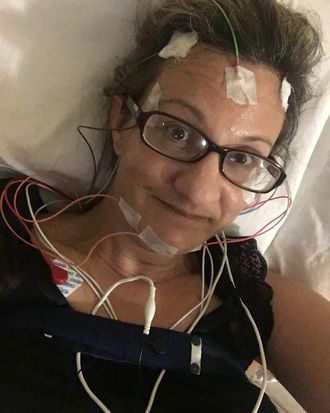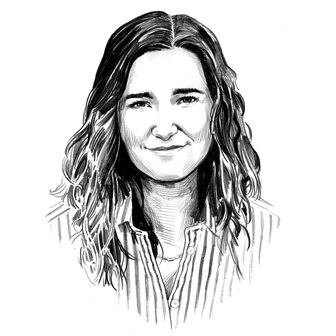
Last week, the FDA declined to ban a form of textured breast implants linked to a rare form of cancer called anaplastic large-cell lymphoma. In a statement, the FDA said the implants, which have been banned in many other countries, pose a low risk, and that more data is needed to justify their ban.
In the same statement, however, the FDA acknowledged that some women with breast implants may experience “breast implant illness,” a condition associated with symptoms like chronic fatigue, pain, cognitive and immune problems. As a result, the FDA is considering a black-box warning (the agency’s most restrictive regulation) for implants associated with these risks. The FDA’s statement follows a two-day hearing in March at which women with breast implant illness demanded more information about the risks associated with implants.
One of these women, Maria Gmitro, shared her experience with this illness.
_
I did my research, and felt like I chose the safest option at the time, which was silicone gel implants in June 2014. My surgeon told me they’d fixed all the issues they had back in the ’90s, and these were FDA-approved, and completely safe. I had the implants placed to correct asymmetry. I really didn’t need to have this corrected, but society made getting implants seem so normal.
I liked the way they looked. They looked great. And I was very healthy at the time. I did barre class, Pilates, played tennis, I had recently been remarried — it was a really positive time in my life, and I was very happy. But within a few months, I started experiencing fatigue, some rashes, some constipation, and some other inflammation issues. I started gaining some weight, even though I hadn’t changed my lifestyle. I started seeing doctors, and I just kind of thought it was because I was turning 40. I thought, okay, life really changes when you turn 40!
From there it progressed. I was more tired, I felt more anxiety, and such fatigue I thought maybe I was depressed, even though I wasn’t. I just couldn’t figure out what on earth was going on, because I was going to the doctor and having tests come back with the normal limits. Fast forward another year — I had more fatigue, more doctors, and was being put on more medications. By the fall of 2016, I had to stop working. I was a teacher, and my husband and I decided we needed to figure out what was going on with my health. I was having autoimmune issues, I was diagnosed with fibromyalgia. We couldn’t figure out what was going on. I worked on a gut health protocol. I was doing all these different protocols the doctors were asking me to, and I wasn’t having much success.
Every time you go to a new doctor, they ask if you’ve had any surgeries. Breast augmentation was the only surgery I’d ever had in my life, so of course I listed it. I mentioned it, but I didn’t really press the issue, because I wasn’t necessarily experiencing pain in my chest. It was more in my neck and upper back, and I didn’t think it was related at first. Once I started really wondering, I would mention it to doctors, and they would just say, ‘Oh, no, the FDA says they’re fine. It’s definitely not your implants.’ Most of the doctors I saw said that. [Breast illness] advocates in the past have dealt with stigma, and felt dismissed by doctors, because augmentation is a cosmetic procedure, but I didn’t.
In the summer of 2017, I was on my computer looking at different support groups I’d joined, and Facebook suggested a page to me called “Breast Implant Illness and Healing by Nicole.” As soon as I joined and read some symptoms, I could feel the blood rush to my face. Oh my gosh, I think these issues are stemming from my implants. It would make sense with the timeline. There were about 15,000 members at that time. [There are now more than 78,000.]
It took my husband a little bit of convincing at first, but then as soon as he started doing a little research, he was like, “Absolutely, you need to get the implants out.” I currently live in Charleston, South Carolina, and at the time the only surgeon [in the area] that could remove them properly was also the one who placed them in. I went back to see him for a consultation, and told him about the symptoms I was experiencing. I told him I had the manufacturer information with me, and it says these issues can happen. He threw his hands up, and said “The FDA says there’s no connection.” So I felt kind of helpless, and embarrassed, and that’s why I ended up choosing a different doctor out of state. In September of 2017, I flew to Dallas and had my implants out.
Immediately I had some relief — bizarre symptoms started to go away. The joint pain in my feet. The brightness in my eyes came back, my skin had more color. I had dry eyes and dry skin and the hydration started coming back. Other aspects seem to be taking longer to heal.
I’ll still have phases where I won’t feel very well, almost flu-like symptoms, but it passes. It seems like I’m having longer stretches of more energy, and feeling well. I try to help that with super-clean eating, and being hydrated. Some of the symptoms come back, but don’t stay very long. It’s not like before. It was like having a hangover every day without drinking. I don’t know how else to describe it. The only time I ever feel like that now is if I really don’t sleep well the night before. The insomnia was terrible, but I’m able to sleep now. I was prescribed so many medications: for sleep issues, constipation, bladder inflammation, migraines, pain from fibromyalgia. Some of them I didn’t take. They had me on a whole list of medications. I’m currently on zero medications, and I’m very proud of that.
I can’t tell you how many times I’ll read another woman’s story [in the Facebook group] and think “I could have written that post.” My story doesn’t even seem important to me now because there are so many more women coming to this group, and it’s the same story. There are a couple of symptoms that are different — we all have different genetic issues, and I don’t really know what another woman might be taking for medication, or how she eats, but there are so many underlying similarities. There’s no doubt in my mind that the implants cause issues, and now the FDA is recognizing that.
After I started healing I reached out to Nicole Deruda, who started the Facebook group, and said “I’m not working right now, I’m focusing on healing, I’d like to help.” Through that I’ve been involved in some advocacy. Sometime in March, the FDA came out with a statement about two of the implant manufacturers, and we were told there would be a public meeting. I applied to speak and was accepted. I went to D.C. at the end of March and spoke in front of the FDA. I got to meet women I had known for a few years — we’d laughed together, cried together, and we’d been working on this advocacy together. I was very nervous to speak, because I don’t love public speaking that much, but I felt called to do it. By day two, we were talking to more surgeons, and the head of the plastic surgery association, and having some informal conversations. It felt pretty positive.
Just last week, the FDA statement came out. They’re not ready to ban the textured implants. I’m a little disappointed by that, but I think with the information that’s coming out, more women will start to do research, and understand that these are linked to cancer. But I am pleased that the FDA are listening, and they are taking steps. This is slow progress, but it is progress. They’re recognizing that breast implant illness does exist. They’re working on a better registry. These devices go through pre-market approval, but it doesn’t seem like there’s been enough long-term studies to make sure these devices are actually safe. That’s why I’m working with a group called Medical Device Problems, and we are going to D.C. next week to lobby for the Medical Device Safety Act. We’re meeting with members of Congress to discuss that bill. My personal goal isn’t necessarily to litigate, but people that have been harmed by these medical devices can’t litigate. The manufacturers are completely protected.
I would love to see these devices studied more thoroughly. I don’t want to take the right from other people to do what they want with their bodies. But we deserve to have a safe product, and if it’s not safe, the FDA should be protecting us. There were a lot of adverse reactions that weren’t reported by the FDA until March. I would like there to be a black-box warning, and I believe that might be coming. I would love for the textured implants to be banned, because they’ve been linked to cancer.
I would also like for the medical community to understand that breast implants are causing this illness. We don’t really have physicians that understand how to help us. I would love for it to be a diagnosable code. Explants cost thousands and thousands of dollars, and I’d love to see financial assistance for that, because women get so sick they have to stop working, and then they can’t afford to get them out. The FDA keeps calling [breast implant illness] rare, but if it’s so rare, help those of us who’ve suffered.


